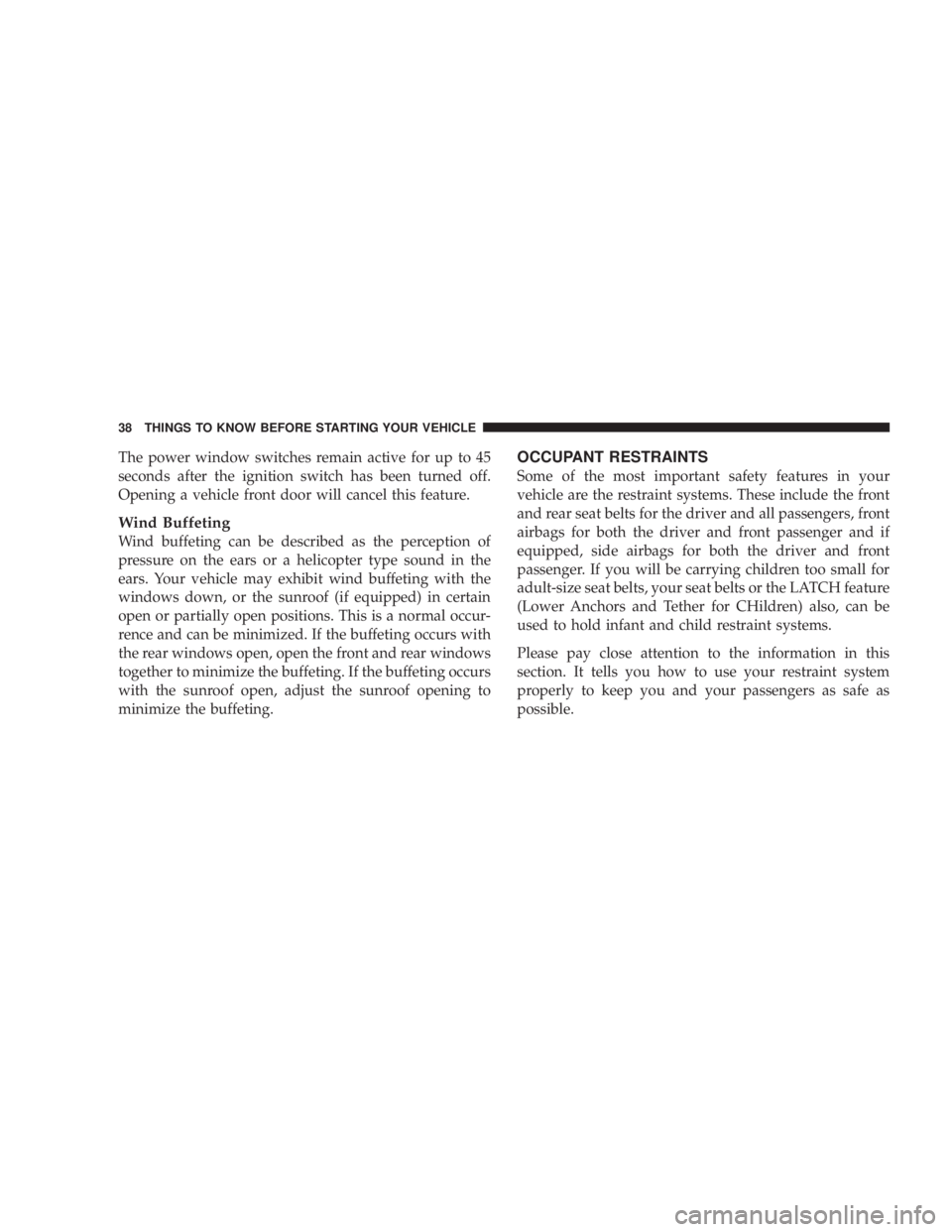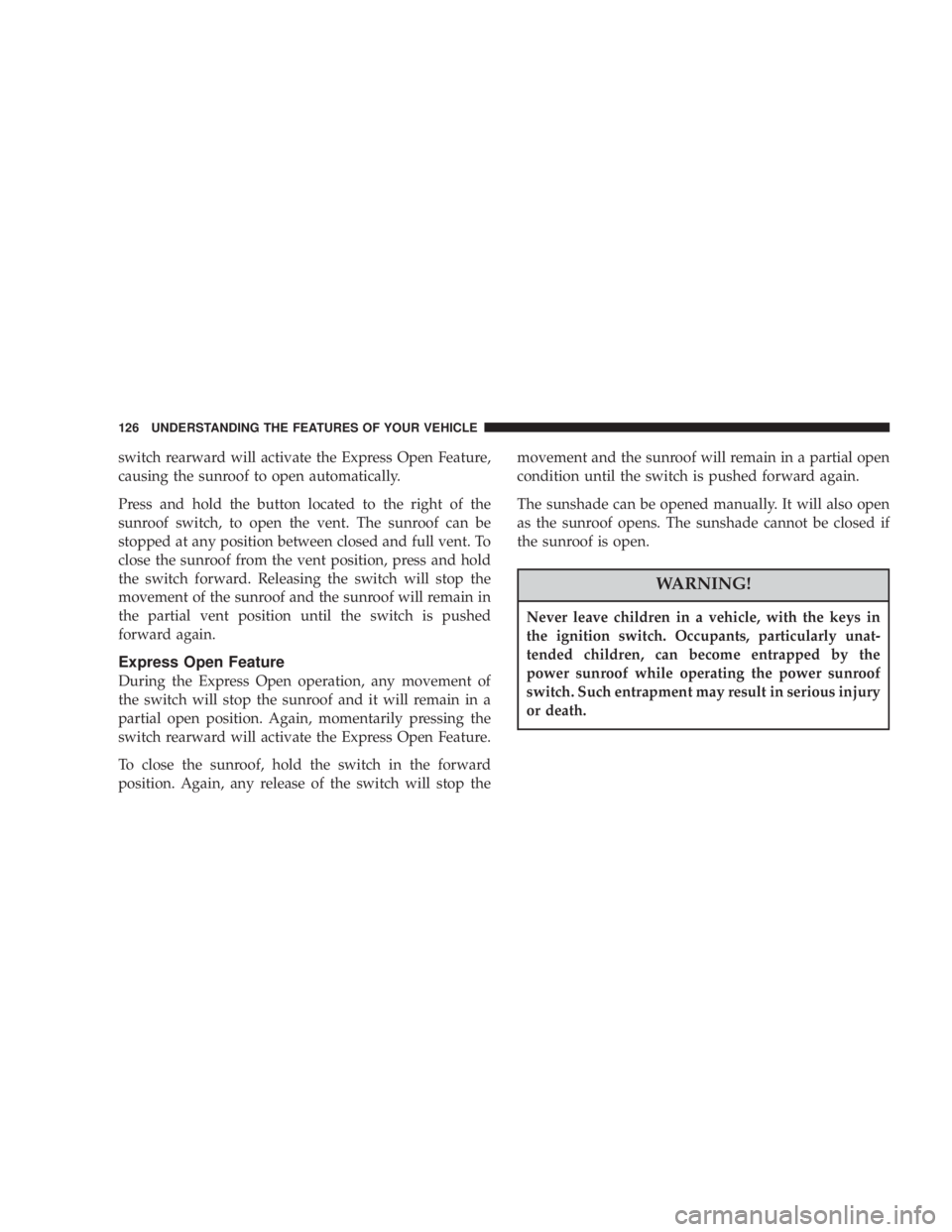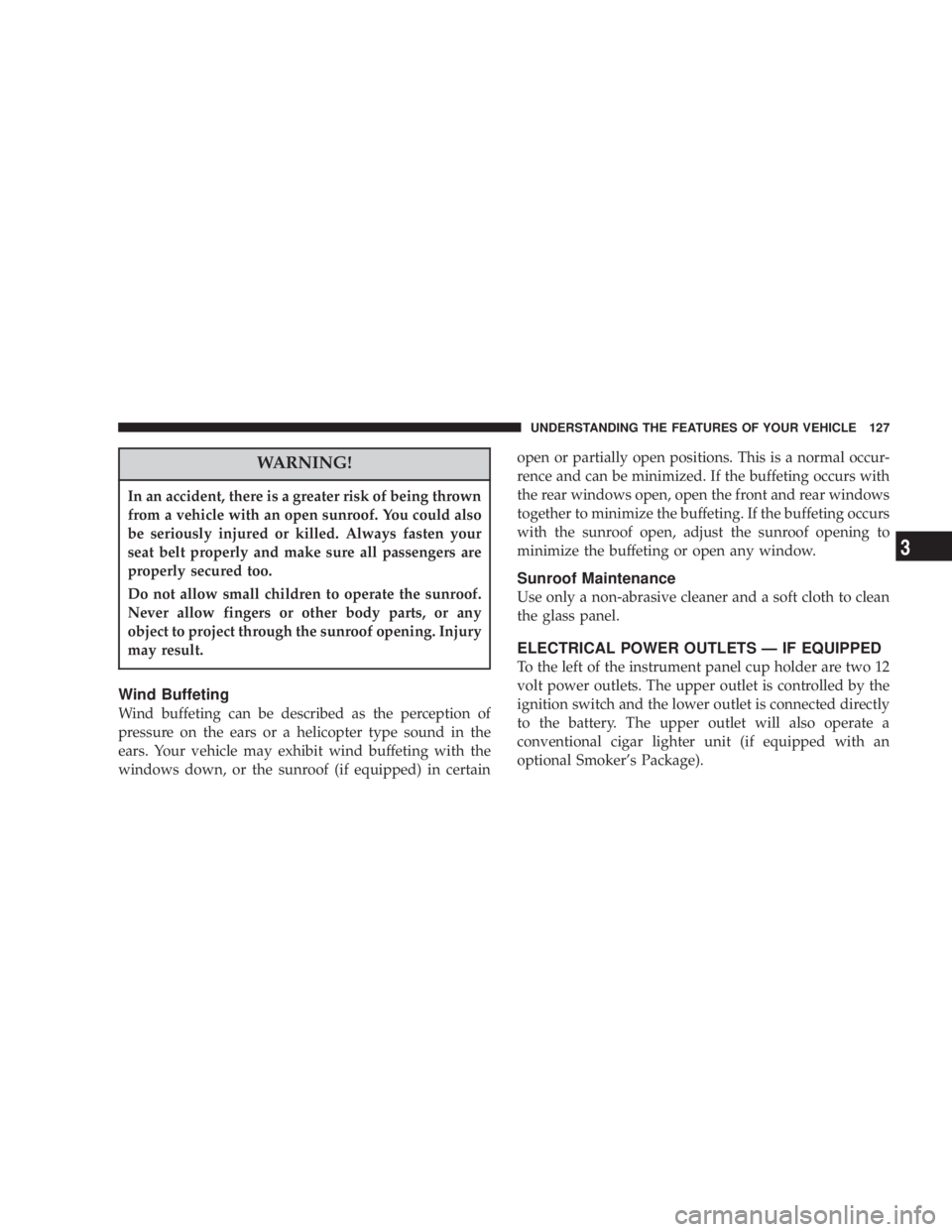Page 38 of 397

The power window switches remain active for up to 45
seconds after the ignition switch has been turned off.
Opening a vehicle front door will cancel this feature.
Wind Buffeting
Wind buffeting can be described as the perception of
pressure on the ears or a helicopter type sound in the
ears. Your vehicle may exhibit wind buffeting with the
windows down, or the sunroof (if equipped) in certain
open or partially open positions. This is a normal occur-
rence and can be minimized. If the buffeting occurs with
the rear windows open, open the front and rear windows
together to minimize the buffeting. If the buffeting occurs
with the sunroof open, adjust the sunroof opening to
minimize the buffeting. OCCUPANT RESTRAINTS
Some of the most important safety features in your
vehicle are the restraint systems. These include the front
and rear seat belts for the driver and all passengers, front
airbags for both the driver and front passenger and if
equipped, side airbags for both the driver and front
passenger. If you will be carrying children too small for
adult-size seat belts, your seat belts or the LATCH feature
(Lower Anchors and Tether for CHildren) also, can be
used to hold infant and child restraint systems.
Please pay close attention to the information in this
section. It tells you how to use your restraint system
properly to keep you and your passengers as safe as
possible.38 THINGS TO KNOW BEFORE STARTING YOUR VEHICLE
Page 76 of 397

N Erasing Homelink Buttons ...............124
N Reprogramming a Single Homelink Button . . . 124
N Security ............................124
m Power Sunroof Ð If Equipped .............125
N Express Open Feature ..................126
N Wind Buffeting .......................127
N Sunroof Maintenance ...................127
m Electrical Power Outlets Ð If Equipped .......127
N Electrical Outlet Use With Engine Off .......129
m Convenience Tray Drawer And Cup Holders . . . 129
N Instrument Panel Cup Holders ............129 N Convenience Tray And Optional Smoker's
Package Kit .........................130
N Rear Cupholders ......................130
m Storage ..............................132
N Front Seat Storage Bin Ð If Equipped .......132
N Removable Floor Console Ð If Equipped ....132
N Rear Compartment Storage Bins ...........135
N Cargo Area Storage ....................135
N Cargo Organizer Ð If Equipped ...........136
m Roof Luggage Rack Ð If Equipped ..........139
m Load Leveling System ...................14176 UNDERSTANDING THE FEATURES OF YOUR VEHICLE
Page 112 of 397

turns in an area free from large metal or metallic objects,
the ªCALº symbol will turn off and the compass will
function normally.
Manual Compass Calibration
If the compass appears erratic and the ªCALº symbol
does not appear, you must put the compass into the
Calibration Mode manually.
To put into a Calibration Mode: Turn on the ignition
switch and set the display to Comp/Temp. Press the
RESET button on vehicles equipped with a Compass/
Mini Trip Computer for at least 10 seconds until the
ªCALº symbol appears. On vehicles equipped with
Compass/Temp press and hold the C/T and US/M
buttons for 10 seconds. Release the RESET button and
complete three 360É turns in an area free from large metal
objects. The ªCALº symbol will turn off and the compass
will function normally. CAUTION!Do not place any external magnets, such as magnetic
roof mount antennas, in the vicinity of the compass.
Do not use magnetic tools when servicing the over-
head console.
Compass Variance
Compass Variance is the difference between magnetic
North and Geographic North. In some areas of the
country, the difference between magnetic and geographic
North is great enough to cause the compass to give false
readings. If this occurs, the compass variance must be set.
NOTE: Magnetic materials should be kept away from
the overhead console.112 UNDERSTANDING THE FEATURES OF YOUR VEHICLE
Page 125 of 397
This device complies with part 15 of FCC rules and with
RSS-210 of Industry Canada. Operation is subject to the
following conditions:
² This device may not cause harmful interference.
² This device must accept any interference that may be
received including interference that may cause undes-
ired operation.
NOTE: Changes or modifications not expressly ap-
proved by the party responsible for compliance could
void the user's authority to operate the equipment.
HomeLink t is a trademark owned by Johnson Controls,
Inc. POWER SUNROOF Ð IF EQUIPPED
The power sunroof control is located between the sun
visors on the overhead console.
Press and hold the switch rearward to fully open the
sunroof. The sunroof can be stopped at any position
between closed and full open. Momentarily pressing the UNDERSTANDING THE FEATURES OF YOUR VEHICLE 125
3
Page 126 of 397

switch rearward will activate the Express Open Feature,
causing the sunroof to open automatically.
Press and hold the button located to the right of the
sunroof switch, to open the vent. The sunroof can be
stopped at any position between closed and full vent. To
close the sunroof from the vent position, press and hold
the switch forward. Releasing the switch will stop the
movement of the sunroof and the sunroof will remain in
the partial vent position until the switch is pushed
forward again.
Express Open Feature
During the Express Open operation, any movement of
the switch will stop the sunroof and it will remain in a
partial open position. Again, momentarily pressing the
switch rearward will activate the Express Open Feature.
To close the sunroof, hold the switch in the forward
position. Again, any release of the switch will stop the movement and the sunroof will remain in a partial open
condition until the switch is pushed forward again.
The sunshade can be opened manually. It will also open
as the sunroof opens. The sunshade cannot be closed if
the sunroof is open.
WARNING!Never leave children in a vehicle, with the keys in
the ignition switch. Occupants, particularly unat-
tended children, can become entrapped by the
power sunroof while operating the power sunroof
switch. Such entrapment may result in serious injury
or death.126 UNDERSTANDING THE FEATURES OF YOUR VEHICLE
Page 127 of 397

WARNING!In an accident, there is a greater risk of being thrown
from a vehicle with an open sunroof. You could also
be seriously injured or killed. Always fasten your
seat belt properly and make sure all passengers are
properly secured too.
Do not allow small children to operate the sunroof.
Never allow fingers or other body parts, or any
object to project through the sunroof opening. Injury
may result.
Wind Buffeting
Wind buffeting can be described as the perception of
pressure on the ears or a helicopter type sound in the
ears. Your vehicle may exhibit wind buffeting with the
windows down, or the sunroof (if equipped) in certain open or partially open positions. This is a normal occur-
rence and can be minimized. If the buffeting occurs with
the rear windows open, open the front and rear windows
together to minimize the buffeting. If the buffeting occurs
with the sunroof open, adjust the sunroof opening to
minimize the buffeting or open any window.
Sunroof Maintenance
Use only a non-abrasive cleaner and a soft cloth to clean
the glass panel.
ELECTRICAL POWER OUTLETS Ð IF EQUIPPED
To the left of the instrument panel cup holder are two 12
volt power outlets. The upper outlet is controlled by the
ignition switch and the lower outlet is connected directly
to the battery. The upper outlet will also operate a
conventional cigar lighter unit (if equipped with an
optional Smoker's Package). UNDERSTANDING THE FEATURES OF YOUR VEHICLE 127
3
Page 139 of 397
Cargo Organizer removal
Unscrew the two plastic fasteners located on the floor of
the rear of the cargo area and remove the cargo organizer
from the vehicle.
NOTE: The cargo organizer must be removed to take
out the third row seat. ROOF LUGGAGE RACK Ð IF EQUIPPED
The crossbars and siderails are designed to carry the
weight on vehicles equipped with a luggage rack. The
load must not exceed 150 lbs (68 kg), and should be
uniformly distributed over the luggage rack crossbars.
Distribute cargo weight evenly on the roof rack crossbars.
The roof rack does not increase the total load carrying UNDERSTANDING THE FEATURES OF YOUR VEHICLE 139
3
Page 141 of 397

CAUTION!² To avoid damage to the roof rack and vehicle, do
not exceed the maximum roof rack load capacity
of 150 lbs (68 kg). Always distribute heavy loads
as evenly as possible and secure the load appro-
priately.
² Long loads which extend over the windshield,
such as wood panels or surfboards, or loads with
large frontal area should be secured to both the
front and rear of the vehicle.
² Travel at reduced speeds and turn corners care-
fully when carrying large or heavy loads on the
roof rack. Wind forces, due to natural causes or
nearby truck traffic, can add sudden upward
loads. This is especially true on large flat loads
and may result in damage to the cargo or your
vehicle. WARNING!Cargo must be securely tied before driving your
vehicle. Improperly secured loads can fly off the
vehicle, particularly at high speeds, resulting in
personal injury or property damage. Follow the Roof
Rack Cautions when carrying cargo on your roof
rack.
LOAD LEVELING SYSTEM
The automatic load leveling system will provide a level
riding vehicle under most passenger and cargo loading
conditions.
A hydraulic pump contained within the shock absorbers
raises the rear of the vehicle to the correct height. It takes
approximately 1 mile (1.6 km) of driving for the leveling
to complete depending on road surface conditions. UNDERSTANDING THE FEATURES OF YOUR VEHICLE 141
3